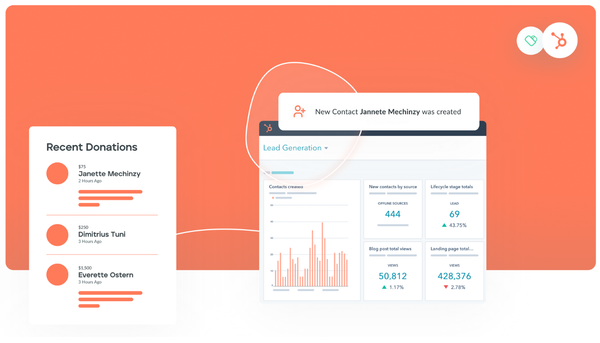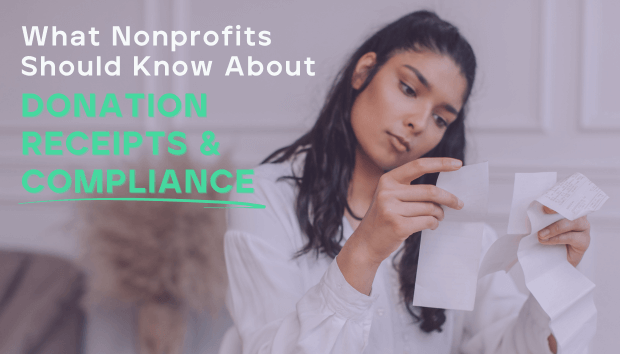6 Ways Data Can Create Meaningful Donor Interactions
Looking to enhance your interactions with donors? Explore this quick guide and learn six data-driven strategies for cultivating meaningful relationships.

This post was contributed by Wild Apricot.
Without the generous support of donors, thousands of causes, services, and programs wouldn’t be able to come to life. That’s because donors are part of the foundation that keeps great causes standing tall and doing good in the world. It goes without saying that having a strong relationship with your donors is one of the first steps in continuing to build future giving and donations.
One part of having that strong relationship with your donors is knowing why they support you. It’s a key component in your organization’s ability to share specific impact and encourage your donors to give time and time again.
Maybe you know all about the why behind your donors’ giving, but don’t have it stored in a way that you can truly use it. Without Constituent Relationship Management (CRM) software, you’re unable to successfully leverage that information to better your meaningful interactions and connections with donors.
Now’s the time to put together your fundraising plan for 2021. Keep these six strategies in mind for a more bountiful new year.
Strategy #1: Storing Topics of Conversation in Your CRM
It’s a trap we all run into at some point or another. You think to yourself “I’ll remember that,” or “I’ll just write it down here and note it later.” Chances are, unless the information is in a safe, consistent place, you’ll forget. That’s why you should save notes about your past conversations in your donor management software. Then, every time you’re about to have a meeting or conversation with your potential donors, you can quickly refresh your memory with this information to drive your discussion.
Plus, you may not be the only person at your organization having conversations with these potential donors. Keeping track in one place helps ensure that a conversation is never missed and everybody at your organization stays informed. There’s nothing worse than a big-time donor feeling like they have to repeat themselves to be heard.
For major donors, it's good to know their interests so you have topics of conversation when you meet with them. Remember that it’s the little touches that could make the most difference. Do small acts that show you care, like sending random articles every now and then that you know they'll enjoy.
Strategy #2: Ask Which Programs They Want to Support When They Sign Up
When a donor gives to your organization, there may be a specific program or service they’d like to support. While general donations are common, donors like to know exactly how their funds will be used. Consider adding areas of interest to your volunteer or membership application form, or even your donation form. Then, make sure to store that information and ensure the donors’ funds help you impact those specific programs.
This is a wonderful opportunity to make a first-time donor turn into a repeat-donor. When you follow up and explain that you followed their wishes the last time they gave, highlighting the direct impact the donation had on your organization, donors will feel more of a personal connection to the past gift. CRM software can help you keep track of the specific programs and services a specific donor supported in the past.
Remember that customization is key. CRM software will allow you to customize your ask letters to include information about specific programs or aspects of your organization that they are interested in supporting.
Strategy #3: Keep Track of Their Donation History
Clear communication keeps donors coming back. You could be doing the best work on the planet, and without the right communication, you would still lose donors. Remember that different groups of donors require different communications.
For example, recurring donors will have different communications tailored to them than those who have only donated once. With first-time donors, you’re encouraging them to remember the programs and services they helped support with their initial donation. You’re asking them to remember how good it felt to make a difference that first time, and to ask them to continue in the future.
Recurring donors are different. You know your recurring donors. You know what services and programs they want to support. It’s your job to keep reminding them that those specific programs or services are going strong because of their support. Without the right CRM solution, you’ll end up providing a blanketed ask with no way to personalize or tailor your message.
The same concept applies to donation amounts — major donors require more stewardship than others. While every donation amount counts, you could rely heavily on a recurring major donor that would be a devastating loss if they took their money elsewhere.
Keeping track of whether a person has made an in-kind donation or received matching gifts from their employers can also help you plan for the future.
Strategy #4: Reach Them Where They Like to Be Reached
Consider how your donors like to give. Maybe they prefer mailing in a check. Maybe it’s the digital ease of donating through your website. The proper CRM tool will give you an idea of what their past giving experiences can tell you.
Along the same lines, it’s important to communicate with your donors in the way they like to be reached. It’s important to know their preferences. For example, if they don’t like checking their email, maybe they prefer text messaging. If you continue to send email after email inviting them to events when they prefer other methods, it’s no wonder they never show.
The same goes for thank you letters, tax receipts, newsletters, and any other form of communication you can think of!
Strategy #5: Customize Your Communications
All of your emails can be personalized using your data. If you have time to write a personalized letter to every single donor, that’s great! However, many of us don’t. That’s where CRM comes in. We don’t recommend sending the same targeted ask to all donors, but you can use CRM to identify certain types of donors, like all first-time donors.
The same goes for segmented communications depending on the interests they’ve indicated they love. Send your donors communications about things they really want to be a part of. At the same time, avoid sending information on projects they’re not as passionate about.
Another idea is to use your data to create customized persona types. While not everybody will fit specifically into each persona type, this helps you easily customize and communicate by providing a baseline. Include the typical ways that each persona type likes to donate, how they like to be communicated with, and so on. When it’s all said and done, give your personas real names like “Frank the First-Time Donor” or “Mary the Monthly Donor.”
Strategy #6: Cultivate Relationships with Potential Donors
While we’ve spoken at length about how data and the right CRM solution can help you build relationships with current donors, there’s one large piece of the puzzle missing. CRM solutions can help you craft communications to warm leads and turn them into lifelong donors.
The right data solution will help you track different types of potential donors such as those who volunteer but don’t yet give, those who have attended an event but have yet to give, and more. Without the proper place to store and use this data, you’re missing out on a very important group of people—those who already have an interest in your organization and have yet to convert. Consider this a way to use data collected from the people who already know and love your organization to form meaningful relationships for years to come. Just because they aren’t ready to donate now, doesn’t mean they won’t be ready in the future.
With the right Constituent Relationship Management solution to organize your data, you’ll no longer have to rely on remembering it all yourself, or using an unorganized system. Remember that it’s not about what you can remember about your donors. Instead, it’s about having the right tools to organize and utilize the data you already have!
Your data is the key to forming meaningful connections and relationships with both your donors today and donors of the future.
As an added bonus, knowing all of these things can help you know what kind of content to create on your membership site’s blog and social media, keeping your prospective donors engaged and making them more likely to donate in the future.
Now get out there and use everything that you’ve learned. We’re wishing you the best of luck putting together your content to engage your donors, both new and the tried and true.





